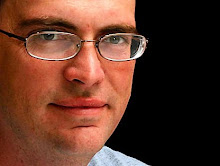So what’s your aperture? The aperture refers to a numerical representation of how wide the lens opening is inside the lens. On all SLR and most point-and-shoot digital cameras, you can open or close your aperture to let more light or less through.
Many people think a lens has only one fixed opening for how much light gets through. But that is not true. The vast majority of cameras (some point-and-shoot film cameras being the lone exception here) have the ability to change the lens’ aperture and let more light through. This is commonly called the f-stop of a lens. The bigger the opening, the more light comes through, and the faster the shutter speed can be.
Similarly, you can change the film speed and get the same results. The higher the film speed, the more reactive to light the film or sensor is, and the faster the shutter speed can be.
This is where one of the biggest strengths of digital cameras comes in. Whereas with film cameras you can change the film speed only by changing the whole roll of film for a new one, with digital you can change the film speed through a camera setting. So if you are shooting at 100 ISO film speed and you notice it is getting a little dark, you can change a digital camera to 200 ISO in between shots and keep going. ISO 200 film is twice as reactive to light as 100 ISO, so it will double your shutter speed.
That is the key to understanding exposure. Being able to double your shutter speed is called one stop of exposure. Therefore, going from 1/125 of a second to 1/250 is one stop, going from 1/125 to 1/500 is two stops, and going from 1/125 to 1/1000 is three stops.
Keeping track of stops with shutter speeds is very simple. Aperture values, on the other hand, are more complex. They start with a very low number (like f2.0) and go up, but not in a scale you would think as logical. A f2 aperture setting creates a large opening in the lens and lets in a lot of light. A f2.8 aperture lets in half of the light as f2, and therefore is one stop less. Two stops less light will be f4, and f5.6 would be three stops less.
Below is a scale showing all of the normal shutter speeds and aperture values, set one stop apart. If your camera was saying that a photo will be properly exposed at 1/125 of a second with an aperture set to f8, then all of the settings below will result in exactly the same exposure.
| Shutter | 1/15 | 1/30 | 1/60 | 1/125 | 1/250 | 1/500 |
| Aperture | f22 | f16 | f11 | f8 | f5.6 | f4 |
| ISO | 100 | 100 | 100 | 100 | 100 | 100 |
Similarly, if you changed your film speed between shots, all of these would result in the same exposure, too.
| Shutter | 1/15 | 1/30 | 1/60 | 1/125 | 1/250 | 1/500 |
| Aperture | f8 | f8 | f8 | f8 | f8 | f8 |
| ISO | 100 | 200 | 400 | 800 | 1600 | 3200 |
Do you see the relationship? As your shutter speed goes up, your aperture value needs to go down. The opposite is also true. As your aperture value goes up, your shutter speed will go down. The key here is to remember that the higher the aperture value, the smaller the lens opening and the less light goes through to expose the photo.





No comments:
Post a Comment